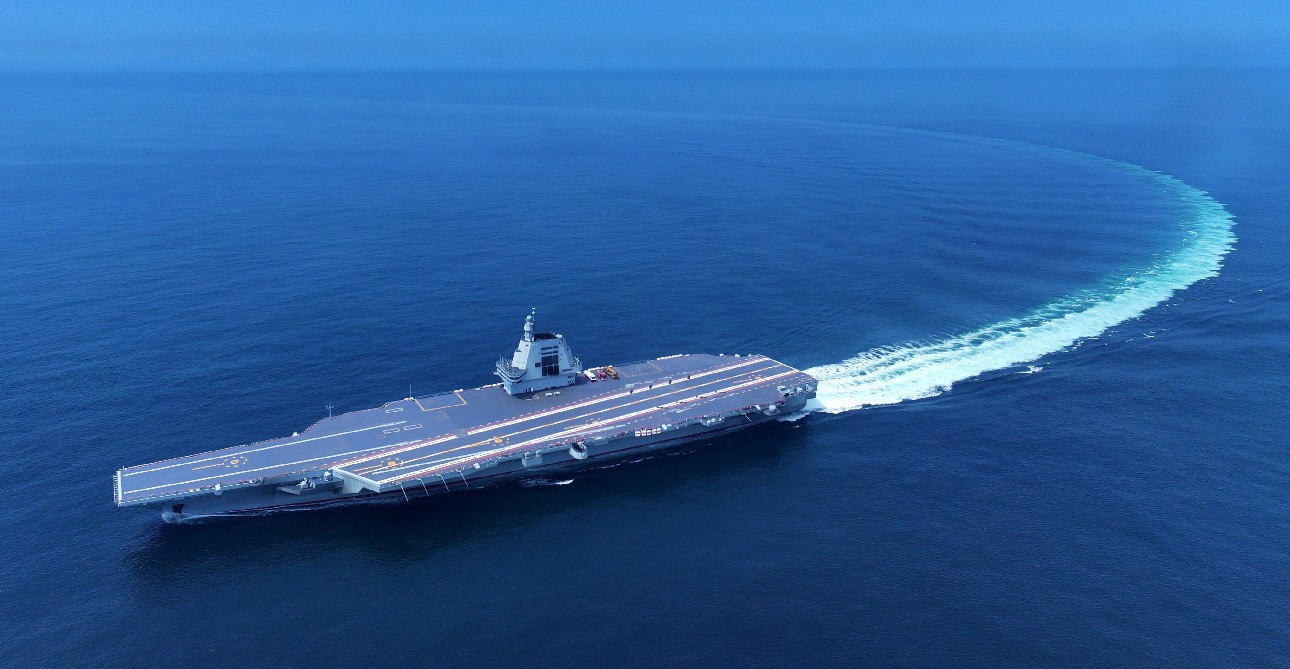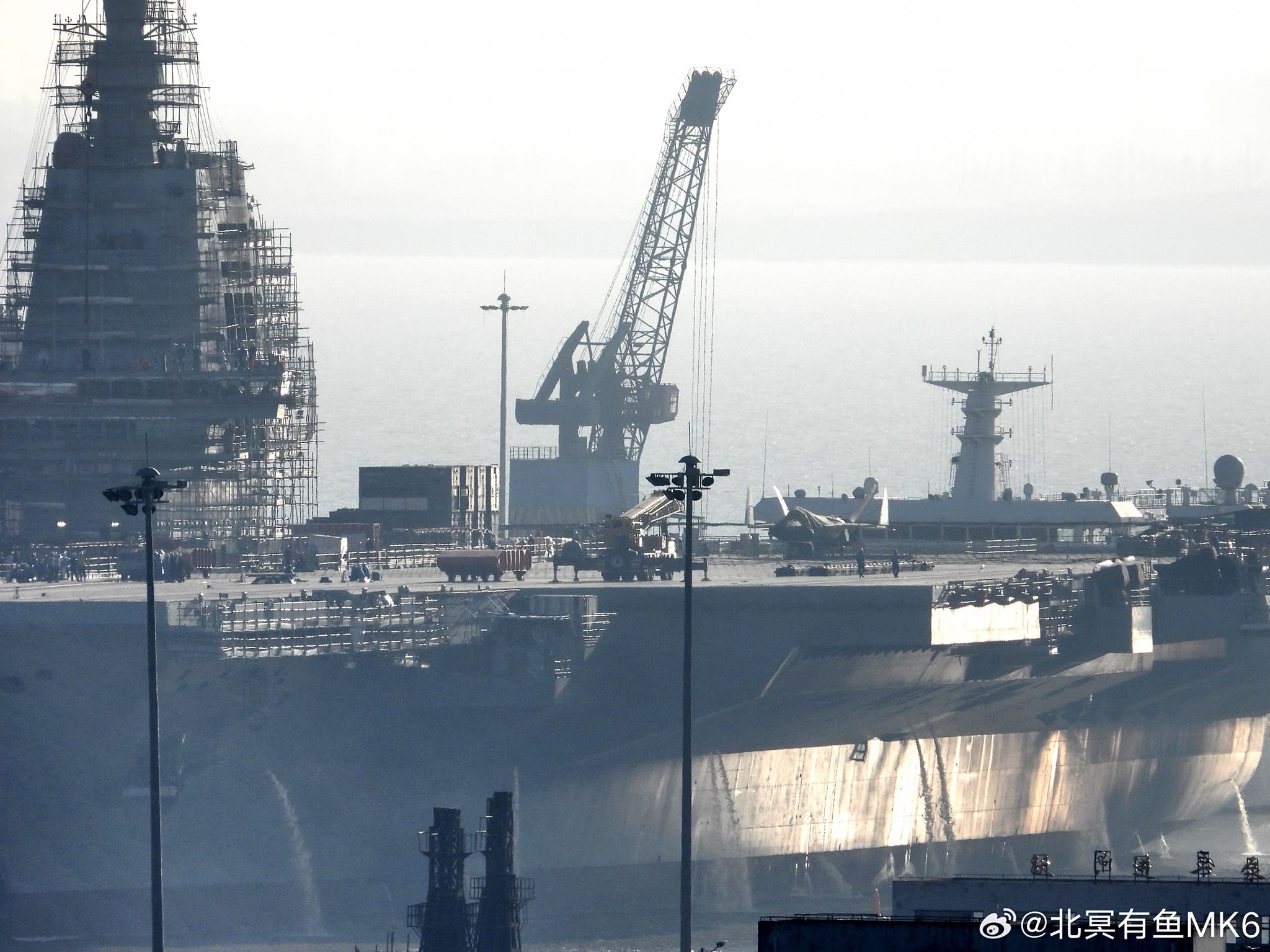The PLA Navy’s newest and most sophisticated aircraft carrier ‘Fujian’ returned to a pier at Shanghai’s Jiangnan shipyard on May 8 after what has been described as a flawless eight-day maiden sea trial.
China’s state-owned media announced that the aircraft carrier successfully tested its electrical and power systems and achieved “the expected results” from its first trial. The propulsion and electrical systems of the Fujian underwent a series of tests, along with other equipment and subsystems.
However, these reports noted that no tests pertaining directly to the carrier’s state-of-the-art electromagnetic catapult technology (EMALS) were conducted during the maiden trial run. The carrier is expected to carry out follow-up testing as planned by the authorities.
Compared to the Liaoning and Shandong aircraft carriers, the vessel’s initial sea trial lasted longer. It took the Shandong six days and the Liaoning five days to finish their maiden trials.
Launched in June 2022, the Fujian is the first aircraft carrier in China to be outfitted with electromagnetic catapults. Chinese experts stated that the Fujian can launch more aircraft because of its larger displacement and electromagnetic catapults, allowing the carrier to launch more effectively.
Using catapult launch systems signifies a significant leap forward in China’s naval capabilities. These systems, more effective than ski jumps, alleviate strain during takeoff, enabling the launch of larger fixed-wing aircraft with heavier payloads and increased fuel capacity.
A noteworthy advancement of Fujian is its ability to accommodate a wide variety of aircraft. It is expected to host upgraded J-15 fighter jets as well as new aircraft, such as the next-generation stealth fighter jet J-35, the fixed-wing early warning aircraft KJ-600, and the JL-10 advanced trainer jet.
According to experts, the J-35 and KJ-600, in particular, will allow Fujian and its air wings to participate in the most advanced forms of modern warfare.

The PLA hopes to have six carriers overall by 2035, making it the second-largest blue-water navy in the world, behind the United States. Additionally, with Fujian’s induction, the PLA will have three carriers, which essentially means that the service could have at least one carrier in active deployment at all times, even if the other two are conducting training missions or undergoing maintenance at a shipyard.

The Fujian is expected to revolutionize China’s maritime capabilities and contribute substantially to Beijing’s strategic goals of defending its interests and establishing its dominance in the Indo-Pacific.
Fujian’s deployment is seen as Beijing furthering its interests and counterbalancing the expansive US maritime influence. China’s state-owned publication, Global Times, quoting experts, says: “At a time when China is facing challenging maritime and aerial security environments, and when the global security environment as a whole is deteriorating, the aircraft carrier Fujian is expected to play important roles in safeguarding national sovereignty, security, and development interests, and it will contribute to peace and stability in the region.”
Interestingly, on the day that China announced the end of Fujian’s maiden trials, an exciting development took place in the South China Sea as the Philippines, the US, and Australia together sank a vessel as part of the ongoing Balikatan 2024 drills.
A (Chinese) Ship Was Sunk By The Philippines & Its Allies
Using an anti-ship cruise missile, the Philippine Navy destroyed a decommissioned tanker in the South China Sea on Wednesday morning as part of the final maritime strike drill for Balikatan 2024.
The US and Philippine forces, supported by an Australian Air Force surveillance aircraft, launched a barrage of high-precision rockets, artillery fire, and airstrikes on May 8 and sank a mock enemy ship under the banner of the Balikatan 2024 military drills in the South China Sea.
In Laoag City, the northern home region of Philippine President Ferdinand Marcos Jr., Ilocos Norte, military officials and diplomats from several nations witnessed the show of force from a hilltop along a sandy shore.
The Philippine Navy’s flagship, BRP Jose Rizal (FF-150), launched a C-Star anti-ship cruise missile at the decommissioned tanker BRP Lake Caliraya (AF-81). Having been hit repeatedly by missile and artillery fire as well as bombs dropped by US and Philippine jets, the mock target ship sank as black smoke billowed from its stern.
Last month, when plans of sinking a mock target first emerged, it was noted with intrigue and astonishment that a Chinese-origin ship had been singled out as a mock target.
菲律賓海軍的第一次,從購買韓國仁川級巡防艦「荷塞·黎剎號」(BRP Jose Rizal, FF-150)後,加裝該國製造的LIGNex1 SSM-700K C-Star反艦飛彈,並成功擊中作為靶船的退役補給艦「卡里拉亞湖號」(BRP Lake Caliraya, AF-81) pic.twitter.com/7uDPxgLGir
— 新‧二七部隊 軍事雜談 (New 27 Brigade)🇹🇼🇺🇦🇮🇱 (@new27brigade) May 9, 2024
The Philippines, however, clarified on April 17 that the vessel’s sinking was not intended to send a message to any specific nation.
Army Colonel Michael Logico, the executive agent and spokesman for Balikatan 2024, stated that the choice to deploy the BRP Lake Caliraya, the Philippine Navy’s sole Chinese-made naval asset, as the target for a sinking exercise was “not intentional” and that warships from several participating nations would carry out the sinking drill in the northern Philippines.
It is not the first time the two partners have sunk a vessel together. However, this time around, every simulation and drill is being keenly watched by China due to the escalation in tensions and the fast-evolving security landscape in the South China Sea.
The highly disputed Spratly Islands region, which China has closely patrolled with its coast guard, navy, and suspected militia flotillas, was the site of the military exercises for the first time in years.
- Contact the author at sakshi.tiwari9555(at)gmail.com
- Follow EurAsian Times on Google News




